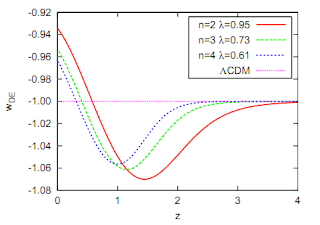A recent paper by Motohashi, Starobinsky, and Yokoyama gives a good synopsis of the general predictions coming from f(R) gravity. But first, what is f(R) gravity? Well, (and if this sentence is too technical just ignore it and read the rest) it is a gravity defined by the following action:
This is identical to the Lagrangian used in Einstein's general relativity except for the addition of the second term on the second line. Therefore, normal GR is equivalent to f(R) gravity for the case when λ = 0.
New Predictions: With the definition out of the way let's get started.
The gravitational constant G: The plot above is of the gravitational constant coming from f(R) gravity, called Geff, divided by the same constant in GR (and Newton) evolving over time.(The variable z is known as the redshift and is a good measure of time for cosmologists and astrophysicists because it is logarithmic in nature and corresponds to the observed redshift of light. See link for more details.)
What is important to note is that, unlike G for Newton and GR, the gravitational constant in f(R) gravity increases over time and evolves differently on different length scales! Thus, if the gravitational constant increases with time and evolves most significantly on the largest scales it could be a hint at f(R) gravity.
The dark energy parameter w: If dark energy is the cosmological constant, than it is characterized by w=-1 in the equation that related the energy density to the pressure of the universe. (Energy density = -1 * Pressure) And, all experiments so far confirm w = -1 so the case for the cosmological constant being dark energy is strong.
However, what could we say about dark energy if we find w does not always equal -1? It turns out this is the case in f(R) gravity and even more peculiar is it crosses from being greater than -1 to less than -1 which throughout the history of the universe which is a fairly robust feature. If this crossing could be observed in the future it would be a big win for f(R) gravity and could not be explained by the dark energy being the cosmological constant.
Okay, any tests on the theory today? Right now there aren't many because general relativity works so well it would only fail on the most extreme scales. (Which we have a hard time probing.) But the authors do include one interesting observation.
On the left is of the matter power spectrum assuming neutrinos are massless. The green line is for standard GR and the others are different f(R) models. The red error bars come from SDSS and show standard cosmology with GR is a good fit. Now, the plot on the right shows the matter power spectrum assuming neutrinos are massive. So if neutrinos are heavy, like for the black line, then f(R) gravity actually fits the data better than GR alone.
Conclusion: f(R) gravity is not the only version of modified gravity that exists but it certainly makes practical predictions. Also, not wanting to make this post 20 pages long, I did not report all predictions the theory makes. However, these are the basic predictions for familiar physics provided by Motohashi et al. and I for one can't wait to see these f(R) theories tested in the coming years.
However, even if f(R) theories are verified, by examining the action above we can still conclude Einstein got the first and by far most dominant term in the Lagrangian right on the money!





No comments:
Post a Comment
To add a link to text:
<a href="URL">Text</a>